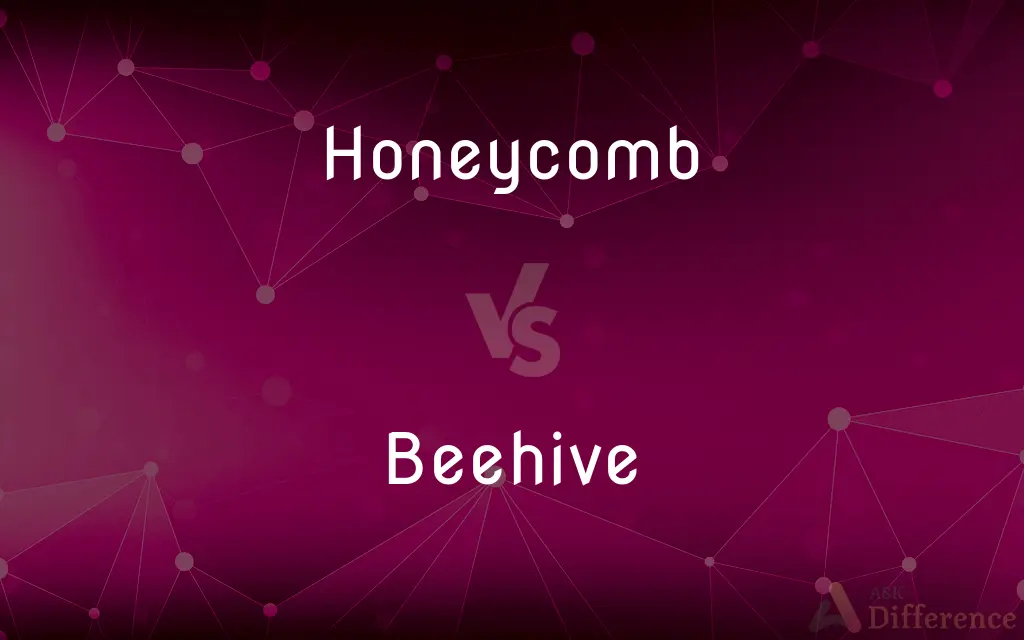Honeycomb vs. Beehive — What's the Difference?
By Tayyaba Rehman & Urooj Arif — Updated on March 26, 2024
Honeycomb, a mass of hexagonal wax cells built by bees for larvae and storing honey and pollen, contrasts with a beehive, the structure housing the bee colony.

Difference Between Honeycomb and Beehive
Table of Contents
ADVERTISEMENT
Key Differences
Honeycomb refers to the intricate structure composed of hexagonal wax cells created by bees within a beehive. These cells are used to store honey and pollen, and to house their larvae. On the other hand, a beehive is the entire structure or enclosure that houses a bee colony, which can be naturally occurring or man-made. The beehive contains multiple honeycombs.
The design of the honeycomb, with its hexagonal cells, is optimized for space and structural efficiency, allowing bees to store the maximum amount of honey while using the least amount of wax. Whereas, the beehive's design (whether natural or man-made) focuses on protecting the bee colony, regulating temperature, and facilitating the production and storage of honey.
Honeycombs are made exclusively by bees from secreted beeswax, and their construction is a fascinating display of natural engineering. In contrast, beehives can be natural, such as hollow trees, or artificial, constructed by beekeepers from various materials including wood, straw, or synthetic substances to house bee colonies.
The role of the honeycomb within the beehive is crucial for the lifecycle of bees, serving as a nursery for larvae and a storage for honey and pollen. Beehives, however, play a broader role in supporting the overall functionality and survival of the bee colony, including providing shelter and facilitating communication among bees.
While honeycomb is directly associated with the production of honey and the growth of new bees, beehives encompass a wider range of activities and responsibilities of the bee colony, including reproduction, protection, and the wintering process.
ADVERTISEMENT
Comparison Chart
Definition
Hexagonal wax cells built by bees for larvae and storage.
Structure housing the bee colony.
Purpose
To store honey, pollen, and house larvae.
To protect and house the entire bee colony.
Composition
Made of beeswax.
Can be made of wood, straw, or natural materials.
Location
Inside a beehive.
Can be found in nature or be man-made.
Structural Focus
Efficiency in storage and space.
Shelter, temperature regulation, colony support.
Compare with Definitions
Honeycomb
Known for its geometric efficiency and natural beauty.
The hexagonal pattern of the honeycomb fascinates scientists and artists alike.
Beehive
Aids in the protection of bees from predators and environmental factors.
The beehive's structure helps maintain a stable internal temperature.
Honeycomb
A structure of hexagonal wax cells built by bees for storage and larvae.
The honeycomb was filled with golden honey.
Beehive
The structure or enclosure that houses a colony of bees.
The wooden beehive in the garden was home to a thriving colony.
Honeycomb
Made exclusively by bees using secreted wax.
Bees work tirelessly to build the honeycomb inside the beehive.
Beehive
Symbolizes community, industry, and cooperation.
The beehive serves as a reminder of the importance of working together for a common goal.
Honeycomb
Crucial for the bee's lifecycle, serving multiple purposes.
Bees use the honeycomb to raise their young and store food.
Beehive
Can be naturally occurring or man-made for beekeeping.
Beekeepers design beehives to facilitate honey production and extraction.
Honeycomb
Represents the internal workings and productivity of a bee colony.
Examining the honeycomb gives insight into the health of the bee colony.
Beehive
Provides shelter and a venue for the bees' social life.
The beehive buzzed with activity as bees communicated and worked.
Honeycomb
A honeycomb is a mass of hexagonal prismatic wax cells built by honey bees in their nests to contain their larvae and stores of honey and pollen. Beekeepers may remove the entire honeycomb to harvest honey.
Beehive
A beehive is an enclosed structure in which some honey bee species of the subgenus Apis live and raise their young. Though the word beehive is commonly used to describe the nest of any bee colony, scientific and professional literature distinguishes nest from hive.
Honeycomb
A structure of hexagonal, thin-walled cells constructed from beeswax by honeybees to hold honey and larvae.
Beehive
A hive for bees.
Honeycomb
Something resembling this structure in configuration or pattern.
Beehive
A very busy place.
Honeycomb
To fill with holes or compartments; riddle
Cliffs that were honeycombed with caves and grottoes.
Beehive
A woman's hairstyle in which the hair is arranged in a tall, rounded peak on top of the head.
Honeycomb
To form in or cover with a pattern like that of a honeycomb.
Beehive
An enclosed structure in which some species of honey bees (genus Apis) live and raise their young.
Honeycomb
A structure of hexagonal cells made by bees primarily of wax, to hold their larvae and for storing the honey to feed the larvae and to feed themselves during winter.
Beehive
A man-made structure in which bees are kept for their honey.
Honeycomb
(by extension) Any structure resembling a honeycomb.
The wood porch was a honeycomb of termite tunnels before we replaced it.
Beehive
(figuratively) Any place full of activity, or in which people are very busy.
Honeycomb
(construction) Voids left in concrete resulting from failure of the mortar to effectively fill the spaces among coarse aggregate particles.
Beehive
A women's hairstyle, popular in the 1960s, in which long hair is styled into a hive-shaped form on top of the head and usually held in place with lacquer.
Honeycomb
(aviation) Manufactured material used to manufacture light, stiff structural components using a sandwich design.
Beehive
A particular style of hat.
Honeycomb
(solar cell) The texture of the surface of a solar cell, intended to increase its surface area and capture more sunlight.
Beehive
A type of anti-personnel ammunition round containing flechettes, and characterised by the buzzing sound made as they fly through the air.
Honeycomb
(geometry) A space-filling packing of polytopes in 3- or higher-dimensional space.
Beehive
(cellular automata) In Conway's Game of Life, a particular still life configuration with a rounded appearance.
Honeycomb
To riddle something with holes, especially in such a pattern.
Termites will honeycomb a porch made of untreated pine.
Beehive
To fill (a place) with busy activity.
Honeycomb
A mass of hexagonal waxen cells, formed by bees, and used by them to hold their honey and their eggs.
Beehive
To style ones hair in a hive-shaped or bouffant form.
Honeycomb
Any substance, as a easting of iron, a piece of worm-eaten wood, or of triple, etc., perforated with cells like a honeycomb.
Beehive
A hive for a swarm of bees. Also used figuratively.
Honeycomb
A framework of hexagonal cells resembling the honeycomb built by bees
Beehive
Any workplace where people are very busy
Honeycomb
Carve a honeycomb pattern into;
The cliffs were honeycombed
Beehive
A structure that provides a natural habitation for bees; as in a hollow tree
Honeycomb
Penetrate thoroughly and into every part;
The revolutionaries honeycombed the organization
Beehive
A hairdo resembling a beehive
Honeycomb
Make full of cavities, like a honeycomb
Beehive
A man-made receptacle that houses a swarm of bees
Common Curiosities
Can a beehive exist without honeycombs?
No, honeycombs are essential for the storage of food and the rearing of larvae within a beehive.
What is the primary function of a honeycomb?
To store honey, pollen, and house bee larvae.
Why are honeycomb cells hexagonal?
The hexagonal shape allows for a highly efficient use of space and materials, maximizing storage capacity and structural strength.
How do bees use the honeycomb during winter?
Bees cluster in the hive and consume stored honey in the honeycomb to survive the winter.
What materials are man-made beehives typically made of?
They can be made of wood, straw, plastic, or other synthetic materials.
Is all honey produced in honeycombs?
Yes, all honey produced by bees is stored in the honeycomb cells.
What distinguishes a beehive from a honeycomb?
A beehive is the structure that houses the bee colony, while the honeycomb is the internal structure made of wax cells for storage and rearing larvae.
Can honeycombs be reused by bees?
Yes, bees can clean and reuse honeycomb cells for storing honey and rearing new larvae.
Do all bees produce honeycombs?
Only honeybees and some related species produce honeycombs; other bee species have different nesting habits.
How do bees create honeycombs?
Bees secrete beeswax from their glands, which they then mold into the hexagonal cells of the honeycomb.
What are the types of beehives?
There are several types, including natural hollows, traditional skeps, and modern box hives.
How do beekeepers harvest honey from beehives?
Beekeepers remove frames containing honeycombs, extract the honey using a centrifuge, and then return the frames to the hive.
What happens to a beehive if the queen bee dies?
The colony may produce a new queen from a young larva or it may collapse if a new queen cannot be produced.
How do bees ventilate the beehive?
Bees fan their wings to circulate air and regulate the temperature inside the beehive.
What role does the honeycomb play in bee communication?
The honeycomb serves as a substrate for the vibrations created by bees' wing and body movements, facilitating communication within the hive.
Share Your Discovery

Previous Comparison
Silver vs. Sliver
Next Comparison
Fat vs. PlumAuthor Spotlight
Written by
Tayyaba RehmanTayyaba Rehman is a distinguished writer, currently serving as a primary contributor to askdifference.com. As a researcher in semantics and etymology, Tayyaba's passion for the complexity of languages and their distinctions has found a perfect home on the platform. Tayyaba delves into the intricacies of language, distinguishing between commonly confused words and phrases, thereby providing clarity for readers worldwide.
Co-written by
Urooj ArifUrooj is a skilled content writer at Ask Difference, known for her exceptional ability to simplify complex topics into engaging and informative content. With a passion for research and a flair for clear, concise writing, she consistently delivers articles that resonate with our diverse audience.















































